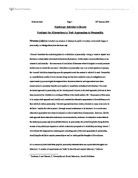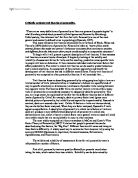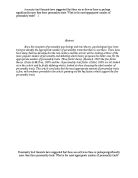An illustration of psychometrics can be seen from Cattell (cited in Thomas, 2002), who took some 18,000 dictionary definitions of personality traits and, using factor analysis, devised a test based on just sixteen personality factors – the smallest number he believed could be reliably used to determine an individual’s personality profile. These included descriptions such as ‘sober,’ ‘shrewd’ and ‘apprehensive’ and each factor was associated with a number of different personality traits. However, while his test has been widely used, it has lost ground to other psychometric tests using just five factors. An example of this is Costa & McCrae’s five factor model (1988) based on key characteristics found across studies and the work of other theorists. Their model consisted of Openness, Conscientiousness, Extraversion, Agreeableness and Neuroticism, with associated traits. Extraversion, for example, is associated with traits such as anxiety, anger, depression and hostility, while Openness includes fantasy, feelings, ideas and values. A different five-factor model (which has become known as the ‘Big Five’) was developed by Goldberg (1981) who determined to identify traits within different cultures using the definitions of their native language, rather than the standardised English lexical terms. Goldberg argued that if sufficient language groups generated identical, stable personality dimensions, those dimensions were probably universal. Such a claim might then go some way to asserting that those personality dimensions were the result of biological or genetic factors (Saucier, et. al., 2000).
This idea of a biological basis for personality has been heavily promoted by Eysenck (1967) who claimed that personality dimensions were caused by individual differences in cortical arousal which in turn was controlled by the ascending reticulocortical activating system (ARAS). This can be illustrated by Eysenck’s assertion that extraversion, for example, was caused by a lack of arousal, thereby creating a need to increase the arousal level, resulting in an extravert personality type. Introversion was the result of over-arousal, causing the individual to behave in a way that would reduce the arousal level. Eysenck maintained that the emotional stability or neuroticism dimensions were controlled by the brain’s limbic system, furthering his belief that personality was the result of a biological and genetic base.
How has trait psychology contributed to the study of personality?
Trait psychology can be credited with making two major contributions. First, the development of psychometric tests is considered one of the foremost elements in the collection of empirically validated data. Unlike other approaches, trait psychology builds its theories from the research results, rather than using subjective and personal experiences as a basis (for example, Erikson’s psychosocial model). Such has been the impact of psychometrics that questionnaires and batteries are used regularly both within various areas of psychology (clinical psychology for example) and commerce (such as recruitment, education and research) to study personality.
Secondly, the work of Eysenck must be acknowledged as significant in that his highly influential theory which proposed biologically and genetically determined behaviour led the way for other theorists to build upon this approach. For example, Loehlin (cited in Thomas, 2002), conducted research into heritability comparisons, examining the traits of monozygotic twins compared with dizygotic twins, showing that environments do not necessarily impact behaviour and concluding that biology was the most likely cause of behaviour variations.
What, then, does trait psychology tell us about personality? My position is that while trait psychology has given us a greater understanding of behaviour, it has not provided substantive evidence that such characteristics equate to a better understanding, per se, of personality. Mischel (1968) criticised trait psychology by emphasising that traits do not predict behaviour very well and that people have a tendency to overestimate personality consistency and importance. He rejected personality assessment as a waste of time, claiming that situationism – the idea that behaviour is the result of the situation and environment in which the behaviour is expressed – was a better contributor to personality studies. I would not go as far as Mischel in rejecting all of trait psychology’s contributions, as it would seem that heritable studies such as the one mentioned above suggest that environments are not always influences on variations in personality and that differences in neurochemistry might be the more likely factor. On the other hand, Zimbardo (1999) in his Stanford Prison Experiment, clearly demonstrates how personality traits may change considerably depending upon the situation, role expectations and conditions. Certain aspects of this experiment also raise issues about the role of social constructionism and its effect on personality.
Furthermore, trait psychology offers few explanations about how traits actually develop, other than to suggest a biological/genetic starting point. This provides little knowledge of how to change or influence traits. Critics of the trait approach maintain that trait theory is therefore disadvantaged in that it offers no means of change and its rationale for measuring something it can do nothing about is therefore questionable.
Conclusion
This essay has looked briefly at trait psychology and has indicated its main contributions to the study of personality. But it has also contended that these contributions have not advanced our understanding of personality as distinct from behaviour. Where does personality stand in relation to behaviour, identity and character? Does personality even exist as a tangible, psychometrically-validatable entity? I would argue that a much greater collaboration between the various theorists involved in trait psychology, bio-genetics, social identity, behaviourism, etc., is needed if personality can be adequately defined. Until then, we may have to agree with Gergen’s (1968) claim that personality exists only in the head and not in the external world.
Word count: 1,098 excluding references








